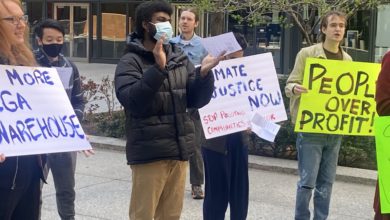Following five hours of testimony by angry teachers, students and parents, the Chicago Board of Education still voted unanimously to close or revamp 16 public schools starting in September.
The Feb. 25 decision will close 12 of the schools because they are running at less than capacity. Poor academic performance is the justification presented for the remaining closures.

Students, teachers and parents take to the streets
to fight for free quality education, Chicago, Feb. 16.
Photo: Stefanie Fisher
Teachers at the schools that were closed for poor performance must now reapply for their jobs. This is part of Renaissance 2010, a plan started in June 2004 by Mayor Richard M. Daley, whose goal is to close “troubled” schools and have 100 charter and privatized schools open by 2010. Arne Duncan, former CEO of Chicago Public Schools and now Obama’s handpicked secretary of education, made a big push for Renaissance 2010.
The school board had originally intended to close 22 schools, but protests by parents, teachers and their community supporters forced Ron Huberman, the new CEO of Chicago Public Schools, to take six schools off the list.
Pending House Bill 363, if passed, will put a one-year moratorium on school closures, consolidations and shakeups. Illinois State Rep. Cynthia Soto (D-Chicago) proposed the legislation in January after learning that the closings would affect two schools in her district.
The night before the vote, dozens of parents and teachers held a candlelight vigil in front of school headquarters at 125 South Clark Street, where they camped out overnight. The police forced them off the premises at 6 a.m.
Following the decision, 500 people protested outside the school headquarters. Demonstrators carried homemade coffins with the names of the closed schools on them. After picketing there, they marched six blocks and rallied again at the James Thompson State Building.
The 16 schools slated for closure are located in low-income Black and Latino areas. Students in those communities will have to travel farther to attend school. Many programs that these affected schools offer will no longer be available. Other schools will have to increase their class sizes to accommodate the displaced students, making it even harder for teachers to give students the individual attention they need.
This is clearly a racist attack aimed at poor communities of color. These schools were underfunded to begin with, setting up students for academic failure. Underperforming schools should be getting more resources—not less—to improve the quality of education.
If the federal and local governments could get their way, education would be fully in the hands of private enterprise. They are slashing budgets, closing schools, cutting teachers’ wages and hiring less qualified, non-union teachers.
This does little to address the needs of working-class families who want their children to have access to quality education. In fact, the trend toward private and charter schools is increasingly turning quality education into an exclusive privilege of the rich. Education must be a guaranteed right for all—stop the closures of public schools!





